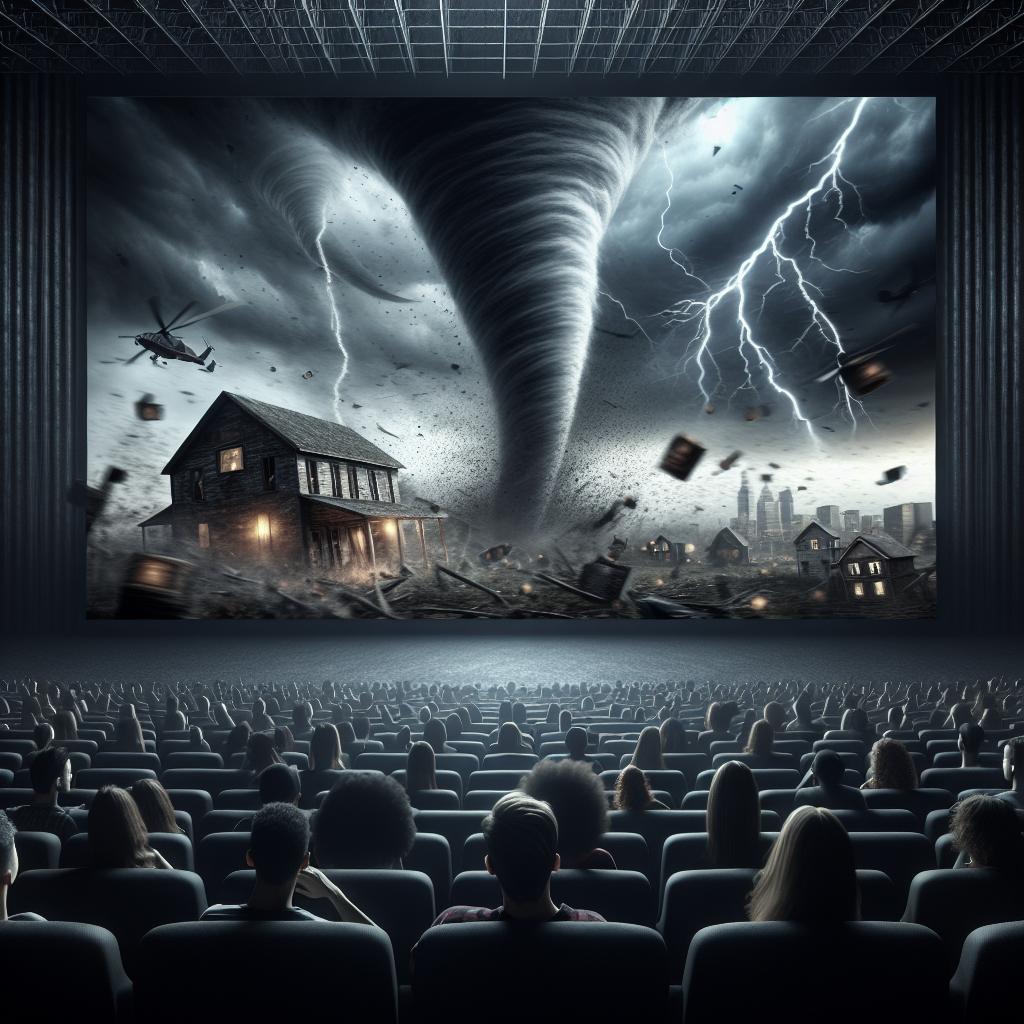Natural disaster movies have a unique allure, combining edge-of-your-seat thrill with raw human emotion. These films often highlight the tenacity of the human spirit in the face of Mother Nature’s wrath. This blog post delves into some of the most compelling natural disaster movies, examining their themes, storytelling, and cinematic execution. From the catastrophic events of “2012” to the social commentary in “Don’t Look Up,” these films offer more than just spectacle—they challenge our perceptions and evoke deep emotions. Let’s take a closer look at these cinematic portrayals of natural disasters and the lessons they convey.
2012
Released in 2009, “2012” is a film directed by Roland Emmerich, renowned for his penchant for grand-scale disaster movies. The plot revolves around the prophecy that the world will end in 2012 according to the Mayan calendar. As global cataclysms unfold, geologist Adrian Helmsley discovers the Earth’s core is heating up, leading to devastating tectonic shifts and catastrophic events. The movie follows several characters as they struggle to survive, highlighting the chaos and heroism that emerge in extreme situations. The visual effects in “2012” are nothing short of spectacular. From crumbling cities to colossal tsunamis, the film leaves no stone unturned in its depiction of global destruction. While the scientific plausibility of the events has been widely criticized, the movie excels in its ability to keep viewers on the edge of their seats. Emmerich’s direction ensures that the film is both a visual and emotional rollercoaster, making it a standout in the genre of natural disaster movies.
Don’t Look Up
“Don’t Look Up,” directed by Adam McKay, is a satirical take on the natural disaster genre. Released in 2021, the film tells the story of two astronomers who discover a comet on a collision course with Earth. Despite their dire warnings, they find themselves facing a society more interested in celebrities and political bickering than in averting a global catastrophe. The film stars Leonardo DiCaprio and Jennifer Lawrence, whose performances bring both urgency and humor to the storyline. The film cleverly uses the impending disaster as a metaphor for climate change and society’s often apathetic response to looming threats. “Don’t Look Up” blends comedy and drama to deliver a powerful message about the importance of listening to scientists and taking action before it’s too late. While the comet serves as the central plot device, the real focus is on human behavior and the choices we make when faced with existential threats.
Sign up to get the BEST of Tom’s Guide direct to your inbox.
Subscribing to Tom’s Guide ensures that you stay informed about the latest reviews, tech news, and practical how-to articles. By signing up, you’ll receive carefully curated content tailored to your interests, whether that’s the latest in natural disaster movies, new tech gadgets, or tips for improving your home entertainment setup. The newsletter delivers the best of Tom’s Guide directly to your inbox, saving you time and keeping you up-to-date with expert insights and helpful recommendations. Stay on top of trends and never miss an update with our comprehensive newsletter. Whether you’re a movie enthusiast looking for the next great film to watch or a tech aficionado eager to learn about the latest innovations, Tom’s Guide has you covered. Our subscription service is designed to provide you with the information you need in a convenient and accessible format, ensuring you’re always in the know.
Skyscraper
“Skyscraper,” directed by Rawson Marshall Thurber, is a 2018 film starring Dwayne Johnson. While it may not fit the traditional mold of a natural disaster movie, it portrays disaster on a grand scale. Johnson plays Will Sawyer, a former FBI Hostage Rescue Team leader and U.S. war veteran, who now assesses security for skyscrapers. When the tallest building in the world suddenly catches fire, Will must act swiftly to save his family trapped inside while uncovering the truth behind the catastrophe. The film excels in creating tension and suspense through its high-stakes setting. The towering inferno and the precarious maneuvers needed to navigate it make for thrilling viewing. “Skyscraper” also explores themes of courage and determination, showcasing the protagonist’s relentless effort to protect his loved ones against overwhelming odds. Although the premise leans toward action more than a natural disaster, the film successfully captures the same intensity and emotion inherent in disaster cinema.
The Ice Road
“The Ice Road,” directed by Jonathan Hensleigh and released in 2021, is a gripping tale of survival and heroism. Starring Liam Neeson, the film follows a group of ice road truckers who embark on a treacherous mission to deliver essential equipment to a collapsed diamond mine in Northern Canada. The frozen landscape poses significant challenges, from cracking ice to severe weather conditions, turning the road into a deadly gauntlet. This film stands out for its unique setting and the high stakes involved in the rescue mission. The icy terrain becomes a character in its own right, with its unpredictable dangers and the constant threat it poses to the drivers. “The Ice Road” combines elements of adventure and drama, emphasizing the human spirit’s resilience and the lengths to which people will go to save others. The film’s portrayal of camaraderie and determination amid relentless natural obstacles makes it a noteworthy addition to the disaster genre.
The Wave
“The Wave” (original title: “Bølgen”) is a Norwegian disaster film directed by Roar Uthaug, released in 2015. The movie is inspired by real-life events and centers around a geologist who discovers signs of an impending avalanche in the Åkneset mountain, which could trigger a devastating tsunami in the fjord below. As the alarm is sounded, the residents of the small village must quickly evacuate, fighting against time and nature’s fury. What sets “The Wave” apart is its grounding in reality and the meticulous attention to detail in its storytelling. The character development and emotional stakes are deeply engaging, making the audience care about the survivors’ fates. The visual effects and the pacing of the film add to the tension, creating a gripping narrative that keeps viewers invested from start to finish. The film’s authenticity and heartfelt performances make it a standout in the realm of natural disaster movies.
Melancholia
“Melancholia,” directed by Lars von Trier and released in 2011, is a unique entry in the natural disaster genre. Unlike traditional disaster films, it delves into the psychological impact of an impending catastrophe. The plot centers around two sisters, Justine and Claire, as a rogue planet named Melancholia is on a collision course with Earth. The film explores themes of depression, existential dread, and the different ways individuals cope with imminent doom. The film’s visual style and narrative structure make it a profound meditation on the human condition. “Melancholia” uses the impending planetary collision as a backdrop to delve into complex emotional landscapes. The performances, especially Kirsten Dunst’s portrayal of Justine, are haunting and deeply affecting. Von Trier’s direction ensures that the film is both visually stunning and thought-provoking, making it a memorable and unconventional take on natural disaster cinema.
The Impossible
Directed by J.A. Bayona, “The Impossible” is a 2012 film based on the true story of a family’s harrowing experience during the 2004 Indian Ocean tsunami. Starring Naomi Watts and Ewan McGregor, the film follows the family as they struggle to survive and reunite in the aftermath of one of the deadliest natural disasters in history. The story is a testament to the strength of familial bonds and the human spirit’s resilience. “The Impossible” stands out for its realistic and heart-wrenching portrayal of the tsunami’s impact. The meticulous recreation of the disaster and the compelling performances make the film a gripping and emotional experience. The narrative focuses on both the immediate chaos of the disaster and the enduring hope and determination of the survivors. The film serves as a powerful reminder of the extraordinary courage and compassion that can emerge in the face of unimaginable adversity.
Related
For more in-depth reviews and articles on natural disaster movies and other film genres, check out our related posts. Discover the nuances of how different directors approach the same genre and the unique storytelling techniques they employ. Our related content section provides links to articles that delve into the making of these films, behind-the-scenes details, and expert analyses of their cultural impact. Additionally, if you’re interested in expanding your knowledge beyond natural disaster movies, explore our range of articles covering various movie genres, tech innovations, and more. Our comprehensive library of content is designed to cater to a diverse array of interests, ensuring you’ll always find something engaging and informative to read.
Tags:
- Natural disaster movies
- 2012
- Don’t Look Up
- Skyscraper
- The Ice Road
- The Wave
- Melancholia
- The Impossible
- Movie reviews
- Cinema
More from Tom’s Guide
For those looking to dive deeper into the world of movies, technology, and more, Tom’s Guide offers a wealth of information and expert advice. Explore our latest articles, reviews, and guides to stay ahead of the curve. From the best streaming services to the top tech gadgets of the year, we’ve got you covered with in-depth analyses and practical tips. Our team of experts continuously updates our platform with the latest trends and insights, ensuring that you have access to the most current and relevant information. Whether you’re a movie buff, a tech enthusiast, or simply looking to stay informed, Tom’s Guide is your go-to source for all things entertainment and technology.
| Movie | Directed by | Year of Release | Main Themes |
|---|---|---|---|
| 2012 | Roland Emmerich | 2009 | Global catastrophe, survival |
| Don’t Look Up | Adam McKay | 2021 | Satire, societal response |
| Skyscraper | Rawson Marshall Thurber | 2018 | Family, heroism |
| The Ice Road | Jonathan Hensleigh | 2021 | Survival, resilience |
| The Wave | Roar Uthaug | 2015 | Tsunami, evacuation |
| Melancholia | Lars von Trier | 2011 | Psychological impact, apocalypse |
| The Impossible | J.A. Bayona | 2012 | Real-life disaster, family |

